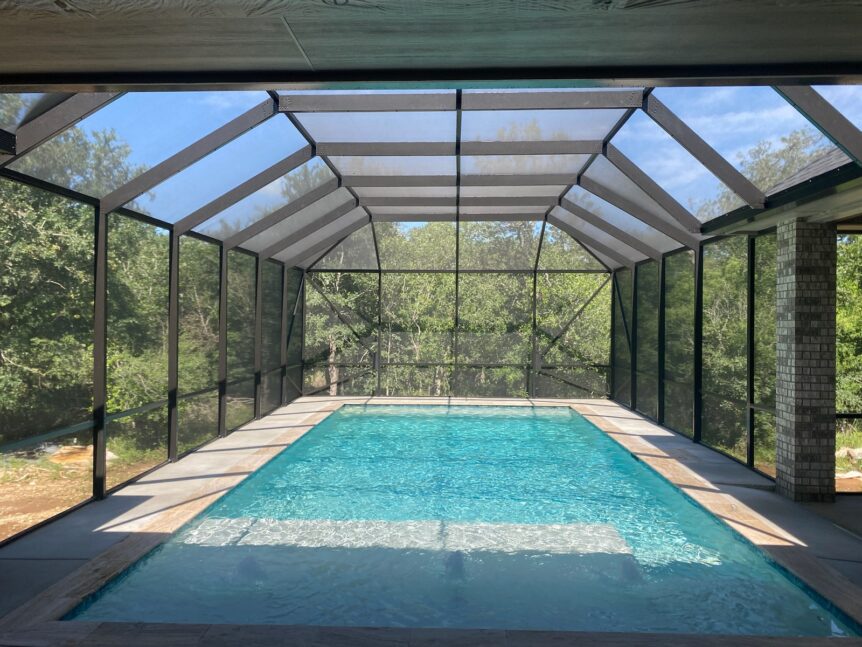As an engineer with extensive experience in designing and constructing swimming pool cages in Austin and San Antonio, I can attest to the critical importance of adhering to specific engineering requirements. These structures not only enhance the usability and longevity of your pool but also contribute to safety, energy efficiency, and overall aesthetics. Let’s delve into the essential engineering considerations when planning a swimming pool enclosure.
Structural Integrity and Load-Bearing Capacity
The first step in any pool enclosure or screened in patio project is to assess the structural integrity of the existing pool area. Engineers must evaluate the load-bearing capacity of the ground, considering factors such as soil type, water table depth, and seismic activity. A stable foundation is crucial to prevent settling, tilting, or collapse over time.
Additionally, the screen patio enclosure’s frame material—whether aluminum, steel, or timber—must meet specific strength requirements. Engineers calculate the anticipated snow loads, wind forces, and dead loads (such as the weight of the enclosure itself) to ensure the structure can withstand varying conditions. Properly designed footings, columns, and beams distribute these loads evenly, preventing stress concentrations.
Wind and Snow Loads

Swimming pool enclosures face constant exposure to the elements. Wind loads are particularly critical, especially in regions prone to strong winds. Engineers analyze wind patterns, local building codes, and the enclosure’s height to determine the necessary wind resistance. The design may incorporate diagonal bracing, reinforced connections, and aerodynamic shapes to minimize wind-induced stresses.
Snow loads vary based on location and climate. Heavy snow accumulation on the roof can strain the structure. Engineers calculate the expected snow load (typically measured in pounds per square foot) and design the enclosure’s roof to handle it safely. Proper drainage systems prevent snow buildup and ice dams, which can compromise the enclosure’s integrity.
Glazing Materials and Thermal Efficiency
The choice of glazing material significantly impacts energy efficiency and comfort. Polycarbonate panels, tempered glass for sunrooms, or double-glazed units provide transparency while insulating against heat loss or gain. Engineers consider factors like solar heat gain coefficient (SHGC), U-values, and light transmission to optimize thermal performance.
To prevent condensation and maintain a comfortable environment, engineers design proper ventilation systems. Louvers, roof vents, and automated openings allow controlled airflow, reducing humidity and preventing mold growth. Additionally, solar control coatings and shading devices minimize excessive heat during hot summers.
Environmental Considerations
Environmental factors play a crucial role in all patio screen enclosure designs, but especially for pool cages. Engineers assess the impact of UV radiation, saltwater exposure (for coastal pools), and chemical treatments (such as chlorine) on the enclosure materials. UV-resistant coatings, corrosion-resistant hardware, and stainless steel components enhance durability.
Safety Measures
Safety is paramount in when building any screen room or pool enclosure. Engineers ensure compliance with local building codes and safety standards. Properly designed doors, locks, and latches prevent unauthorized access. Additionally, engineers consider emergency egress options, fire safety, and childproof features.
Aesthetics and Integration
While functionality is essential, aesthetics matter too. Engineers collaborate with architects and designers to create an enclosure that seamlessly integrates with the surrounding landscape and architectural style. Customizable features like retractable roofs, sliding panels, and decorative elements enhance the overall appeal.
Building a swimming pool enclosure requires a multidisciplinary approach, combining engineering expertise, architectural vision, and practical considerations. By addressing structural requirements, environmental factors, and safety concerns, engineers ensure a well-designed, durable, and visually pleasing enclosure that enhances your pool experience year-round.
Call the professionals at in San Antonio or Austin at Texas Patio Covers for additional detail.

